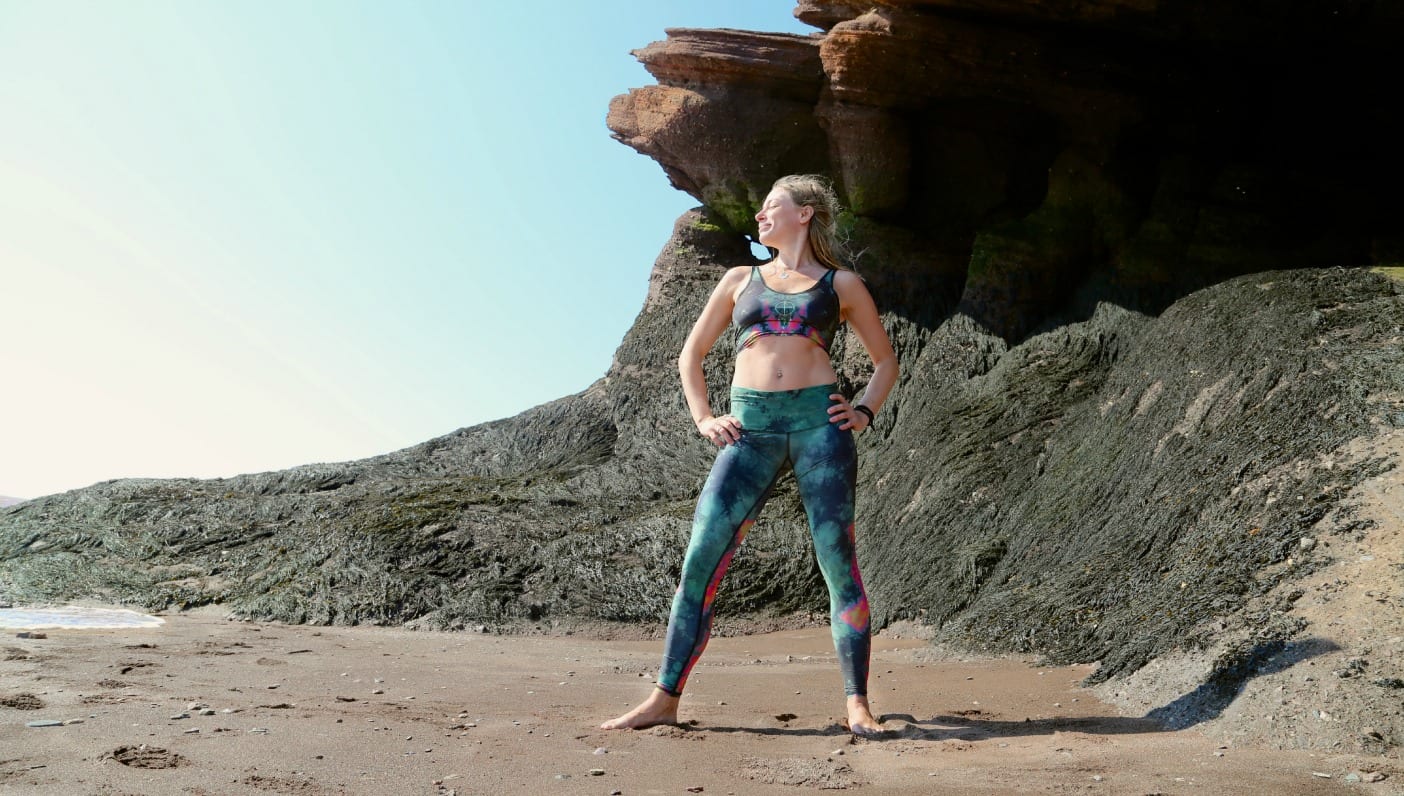
A couple years ago, Alexandria Crow, a Los Angeles-based teacher and founder of Yoga Physics, invited me to what was advertised as a “backbend workshop” at YogaWorks in New York City. I was ready and willing to take on challenging asanas like Scorpion (Vrschikasana), or a Hollow Back Forearm Stand (Pincha Mayurasana). Ever since my earlier days as a gymnast, my spine has been very flexible, easily bending and contorting itself into many challenging poses. Or so I thought…
Within the first ten minutes of the session, Alex brought out a demo skeleton. That’s when I realized what I had actually signed myself up for. There would be little to no backbends—the primary focus of the workshop was to study the spine from the inside out, revealing the one underlying issue that over 80 percent of all yoga practitioners have. Drumroll, please: Tight psoas.
Oh, but that can’t possibly be me! My hips are open and my spine is flexible. How could these tiny little muscles deep within my hip joints have anything to do with my backbending abilities… wait, what?!
The psoas start in the legs and run all the way to the T12 vertebrae, the same place where the diaphragm also connects. The psoas are the only muscles that attach your legs to your spine, and if they tighten, your lower back becomes compromised. Known as “the muscles of the soul,” the connection of the psoas and diaphragm is significant—leading to shortness of breath and even triggering anxiety.
OK, but what does this have to do with tucking the tailbone—or not? As a yoga practitioner of 15 years and a teacher for five, I’ve obediently listened to the common cue to “tuck your tailbone,” and have (until now) also instructed this to my students. As a result, my lumbar spine is hard as a rock. The tightness there, which I mistook for strength, is a result of shortened psoas muscles from an overly tucked tailbone. My lower back is compressed, making me more susceptible to injury, despite my hypermobile, super flexible spine. And yes, I’m often short of breath, despite years of pranayama practice.
But yoga is not the only culprit.
Like a sign from the universe, I stumbled across an article in Medium a few days later, validating my newfound insight:
Even though we now have only the beginning of what was once a real mammalian tail, it behaves the same. Untucking the tailbone opens the pelvic outlet, tucking it closes it — tightening the pelvic floor. The dog with his tail down between his legs is an equivalent of you sitting on your sacrum, the back supported by a chair or a couch. If you spend multiple hours a day in this position, your pelvic floor doesn’t really have a chance to release and allow the muscle fibres to regain their natural length at resting state. So gradually it shortens.
Biomechanicist Katy Bowman compares an optimally functioning pelvic floor to a trampoline. It supports the weight of all our pelvic organs and allows any extra load to just bounce off its healthy, elastic fibres, tensing and releasing naturally. Keeping the muscles short all the time doesn’t let them perform their function optimally. And further on, as our bodies naturally adapt to the way we use them, we gradually end up with shortened muscles.
It’s not surprising that the vast majority of evolved humans walk around with tight psoas because we all know that we sit too damn much. They key to begin breaking these old habits and retraining our bodies is to access the psoas, deep within the hips, and continue strengthening the core. I teach a lot of core work in my classes, and in basic poses like Mountain (Tadasana), Chair (Utkatasana), and Downward Dog, I encourage my students to stick out their butts, bounce a little, and even wag their tails.
However, we ought to approach core strengthening exercises with caution. If we lose the neutral curve in our spine during core work (think soft S-shape), we jeopardize the health of our lower back, because it is pulled into an extreme arch. Full disclosure: It was precisely this exaggerated arch which I always thought had felt so good.
Yoga Journal offers some perspective:
The problem is that your core is most often no match for the combined power of your psoas and gravity. The end result is that tremendous pressure is placed on your lumbar spine, which causes your low back to overarch and can lead to low-back pain or even to injury.
The physiotherapist Leon Chaitow, an osteopath and senior lecturer at the University of Westminster in London, points out that when you practice a sit-up (lifting your entire torso all the way up and off the floor), the pull of the psoas compresses the disk between the vertebrae known as L5 and S1 (the place where your lumbar spine meets your sacrum) with the force of about 100 kilograms—or 220 pounds! That’s quite a squeeze to put on your low back for the sake of a flat belly.
We live in a culture that is seemingly inundated with back problems, and previous medical diagnoses might have blamed aging, childbirth, or heavy lifting, with the solutions being prescribed medication or even surgery. But modern science is catching up to what many healing practitioners have already known—that an underlying issue exists for nearly every physical ailment.
And just like science, modern yoga is also evolving. What we thought was safe before might no longer be, and vice versa. More poses are now safe for pregnancy than previously thought for instance, and the idea of untucking your tailbone is slowly catching on. If you sit for prolonged periods of time and can’t avoid it, standing desks have also become an option—but you could also just stand up and move around more often throughout the day. Just be wary of how your pelvic floor is positioned.
It is still up for debate whether or not it’s better to contract the glute muscles to protect the lower back, though I have found it beneficial for my own practice as of late. And the simplest, and perhaps most relaxing, way to find relief from low back pain and tight psoas is spending some time in Legs Up the Wall Pose (Viparita Karani). This gentle, yet powerfully restorative shape is also great for activating your parasympathetic nervous system, helping to alleviate stress and anxiety and—you guessed it—helping release your diaphragm.
Yoga International explains the connection of the psoas and diaphragm to your lower back:
A diminished lumbar curve may lead to disc problems in the lower back, sciatic pain, and even shoulders that are too far forward. It also has dire consequences for the lower organs, which need space to move. And, from a subtle-body perspective, when we put a “clamp” on the tailbone, we interfere with apana, the downward movement of energy.
So if you struggle with feelings of anxiety, have trouble taking in a full deep, breath, or suffer from lower back pain or tightness, then please, do yourself a big favor—make like our ancestors and stop tucking your tailbone. Your spine will thank you.
—
 Andrea Rice is a writer, yoga and meditation teacher, and Wanderlust Festival presenter. Her articles and essays have appeared in The New York Times, Yoga Journal, The Wanderlust Journal, NY Yoga + Life, mindbodygreen, and SONIMA, among other publications. She has been teaching yoga since 2010, first in Brooklyn and Manhattan, and now in Raleigh, NC, where she currently resides. She is also co-authoring a book about the application of seasonal rhythms and yoga philosophy to modern life, which will be published by New Harbinger in early 2020. Connect with Andrea on Facebook, Instagram, and Twitter, and sign up for her quarterly newsletters on her website: www.andreariceyoga.com.
Andrea Rice is a writer, yoga and meditation teacher, and Wanderlust Festival presenter. Her articles and essays have appeared in The New York Times, Yoga Journal, The Wanderlust Journal, NY Yoga + Life, mindbodygreen, and SONIMA, among other publications. She has been teaching yoga since 2010, first in Brooklyn and Manhattan, and now in Raleigh, NC, where she currently resides. She is also co-authoring a book about the application of seasonal rhythms and yoga philosophy to modern life, which will be published by New Harbinger in early 2020. Connect with Andrea on Facebook, Instagram, and Twitter, and sign up for her quarterly newsletters on her website: www.andreariceyoga.com.